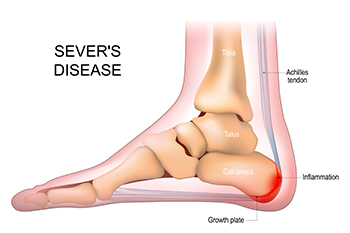
Sever's disease, also known as calcaneal apophysitis, is a common ailment among adolescents, particularly those engaged in active pursuits, like sports. This condition occurs when the growth plate at the back of the heel, where the Achilles tendon attaches, becomes inflamed. Typically affecting children aged 8 to 15 during growth spurts, Sever's disease is often linked to the rapid skeletal development that outpaces the tightening of the Achilles tendon. The repetitive stress on the growth plate from physical activities can lead to discomfort, swelling, and pain at the heel. If your active child has heel pain, it is suggested that you visit a chiropodist who can confirm a Sever’s disease diagnosis, and offer correct treatment methods.
Sever’s disease typically affects young children and teenagers. If your child complains of foot pain, please consult with one of the chiropodists from Complete Family Footcare & Therapy. Our clinicians will assess your condition and provide you with quality foot and ankle treatment.
What Is Sever’s Disease?
Sever’s disease, also known as calcaneal apophysitis, is an inflammation of the growth plate in the heel bone. It is typically caused by overuse due to repetitive activities such as running, jumping, and playing certain sports. This condition most frequently affects children between the ages of 8 and 14.
Symptoms
Symptoms of Sever’s disease include:
Pain in the back or bottom of the heel
Pain when the sides of the heel are squeezed
Limping or walking on tiptoes to avoid putting pressure on the heel
Difficulty running, jumping, or participating in usual activities
Fatigue
Diagnosis
Sever’s disease is diagnosed by taking a thorough medical history and performing a physical examination. Imaging studies, such as an X-ray, can help rule out other injuries like a fracture.
Treatment
Sever’s disease typically heals without any long-term complications. Treatment involves resting the affected foot by reducing typical activities, wearing orthotics to support the foot, immobilizing the affected foot, taking medications to reduce pain and inflammation, and stretching the foot.
If you have any questions, please feel free to contact our offices located in . We offer the newest diagnostic and treatment technologies for all your foot care needs.
